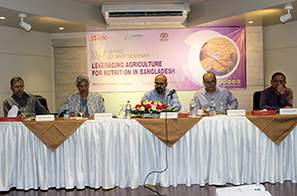
Children living in the coastal and wetland (haor) regions in Bangladesh are 1.5 times more likely to be stunted - one of the findings from a study conducted by LANSA, led by BRAC. The study explores agricultural innovations to fight malnutrition in Bangladesh.
The study identified haors and the coastal belt in Bangladesh, which are geographically distinct from other parts (waterlogged and salinity affected areas, respectively), as pockets of undernutrition. Analysis showed that overall prevalence of stunting ranged from 46.6% in the haor basin to 30.9% in other parts of Bangladesh, whereas the prevalence of underweight ranged from 44.5% in the haor basin to 34.1% in other areas. This is a serious cause of concern for the country.
This was revealed at the concluding seminar for the Leveraging Agriculture for Nutrition in South Asia (LANSA) – an international research partnership of which BRAC is a partner. The seminar titled ‘Leveraging Agriculture for Nutrition in Bangladesh’ was held at the BRAC Centre today, 23 July 2018. LANSA programme is funded by UKaid.
The chief guest at the seminar was Fazle Wahid Khondaker, Additional Secretary (Research) of the Ministry of Agriculture. The seminar was chaired by Dr Imran Matin, executive director of BRAC Institute of Governance and Development. Dr Samir Kanti Sarker, director of Institute of Public Health and Nutrition (IPHN), Dr Lalita Bhattacharjee, senior nutritionist of FAO, Prof Abdul Bayes, former director of Research and team lead of LANSA BRAC also spoke on the occasion.
Research revealed there is a strong interrelation between crop diversity, diet diversity and nutritional outcomes. It was found that the number of people with malnutrition will decrease if we increase production of diet-diverse and nutrition-rich food items.
The seminar emphasised that there is a need to increase public awareness on these issues. The discussants and participants at the seminar called for the government to take up more initiatives in encouraging farmers to cultivate diverse crops in order to increase nutritional outcomes.
The Additional Secretary Fazle W Khondaker, in his speech, mentioned that the government is working towards attaining the Sustainable Development Goals by 2030. Agriculture remains the most important tool to achieve the targets and overall development. However, right now the country’s agriculture is facing major challenges with the adverse effects of climate change, labour shortages, floods and flash floods, severe storms, tidal surges, and other natural disasters.
He said, “Agriculture is directly related to our food and nutrition. So we are working towards sustainable agricultural practices and systems, and food security. To achieve this, all sectors need to work in close collaboration with each other.”
Dr Samir Kanti Sarker said, “There is a need for health education along with the regular education system. Knowledge regarding food is necessary to ensure nutrition outcomes. We need to have an integrated approach towards building this knowledge.”
Dr Imran Matin mentioned that to achieve better nutrition, three things should be focused on among others: the role of access to information, the role of agriculture incentives and the role of food consumption behaviour. It is time to go for interventions and identify cost effective approaches to address malnutrition through agriculture.
A synthesis of LANSA research studies was presented by Barnali Chakraborty, senior research fellow of BRAC’s research and evaluation division. Dr Lalita Bhattacharjee, senior nutritionist of FAO presented a paper on ‘Agriculture and Nutrition: Lessons learned from FAO Projects on Food based nutrition strategies’. Dr Mahfuza Rifat, programme head of BRAC’s health, nutrition and population programme, presented a paper on ‘Nutrition Interventions of BRAC’.
The seminar discussed different approaches to combat malnutrition for the people living in poverty, like, school nutrition/feeding programme, encouraging more consumption of milk, increased food storage, and processing capacity, etc.
The discussants recommended that special programmes should be adopted in response to the special needs of geographically fragile and vulnerable areas of the country.









